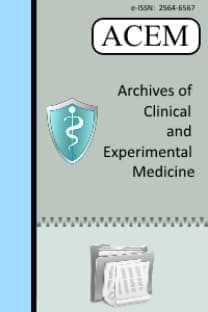İşitme cihazının presbiakuzili yaşlılarda işitme engelliliğine olan etkisinin araştırılması
İşitsel engellilik envanter skalası, işitme cihazı, işitme kaybı, presbiakuzi, sensorionöral, yaşlı
Investigation of the effect of hearing aid on hearing disability in elderly people with presbycusis
Hearing handicap inventory scale, hearing aid, hearing loss, presbycusis, sensorineural, elderly,
___
- 1. Dalton DS, Cruickshanks KJ, Klein BE, Klein R, Wiley TL, Nondahl DM. The impact of hearing loss on quality of life in older adults. Gerontologist. 2003;43:661-8.
- 2. Byun YS, Kim SS, Park SH, Park EB, Kim HJ, Kim SH, et al. Characteristics of patients with hearing aids according to the degree and pattern of hearing loss. J Audiol Otol. 2016;20:146-52.
- 3. Lotfi Y, Mehrkian S, Moossavi A, Faghih-Zadeh S. Quality of life improvement in hearing-impaired elderly people after wearing a hearing aid, Arch Iran Med. 2009;12:365-70.
- 4. Crispim KGM, Ferreira AP. Prevalence of self-reported hearing loss and associated risk factors among the elderly in Manaus: a population-based study. Rev CEFAC. 2015;17:1946-56.
- 5. Paiva KM, Cesar CL, Alves MC, Barros MB, Carandina L, Goldbaum M. Aging and self-reported hearing loss: a population-based study. Cad Saude Publica. 2011;27:1292-300.
- 6. Fischer N, Weber B, Riechelmann H. Presbycusis - age related hearing loss. Laryngorhinootologie. 2016;95:497-510.
- 7. Carniel CZ, Sousa JCF, Silva CDD, Fortunato-Queiroz CAU, Hyppolito MÂ, Santos PLD. Implications of using the hearing aids on quality of life of elderly. Codas. 2017;29:e20160241.
- 8. Smeeth L, Fletcher AE, Ng ES, Stirling S, Nunes M, Breeze E, et al. Reduced hearing, ownership, and use of hearing aids in elderly people in the UK – the MRC trial of the assessment and management of older people in the community: a cross-sectional survey. Lancet. 2002;359:1466-70.
- 9. Rutman D, Boisseau B. Acquired hearing loss: social and psychological issues and adjustment processes. Int J Rehabil Res. 1995;18:313-23.
- 10. Weinstein BE, Ventry IM. Audiometric correlations of the Hearing Handicap Inventory for the elderly. J Speech Hear Disord. 1983;48:379-84.
- 11. Veras RP, Mattos LC. Audiology and aging: literature review and current. Braz J Otorhinolaryngol. 2007;73:122-8.
- 12. Uriarte M, Denzin L, Dunstan A, Sellars J, Hickson L. Measuring hearing aid outcomes using the Satisfaction with Amplification in Daily Life (SADL) questionnaire: Australian data. J Am Acad Audiol. 2015;16:383-402.
- 13. Wong LL, Hickson L, McPherson B. Hearing aid satisfaction: what does research from the past 20 years say? Trends Amplif. 2003;7:117-61.
- 14. Knudsen LV, Oberg M, Nielsen C, Naylor G, Kramer SE. Factors influencing help seeking, hearing aid uptake, hearing aid use and satisfaction with hearing aids: a review of the literature. Trends Amplif. 2010;14:127-54.
- 15. Jerram JCK, Purdy SC. Technology, expectations, and adjustment to hearing loss: predictors of hearing aid outcome. J Am Acad Audiol. 2001;12:64-79.
- 16. Chang WH, Tseng HC, Chao TK, Hsu CJ, Liu TC. Measurement of hearing aid outcome in the elderly: comparison between young and old elderly. Otolaryngol Head Neck Surg. 2008;138:730-34.
- 17. Brooks DN, Hallam RS. Attitudes to hearing difficulty and hearing aids and the outcome of audiological rehabilitation. Br J Audiol. 1998;32:217-26.
- 18. Mulrow CD, Tuley MR, Aguilar C. Correlates of successful hearing aid use in older adults. Ear Hear.1992; 13:108-13.
- 19. Hosford-Dunn H, Halpern J. Clinical application of the SADL scale in private practice II: predictive validity of fitting variables. Satisfaction with amplification in daily life. J Am Acad Audiol. 2001;12:15-36.
- 20. Korkmaz MH, Bayır O, Er S, Isık E, Saylam G, Tatar EC, et al. Satisfaction and compliance of adult patients using hearing aid and evaluation of factors affecting them. Eur Arch Otorhinolaryngol. 2016;273:3723-32.
- 21. Vuorialho A, Karinen P, Sorri M. Effect of hearing aids on hearing disability and quality of life in the elderly. Int J Audiol. 2006;45:400-5.
- 22. Choi J, Chung WH. Age-related hearing loss and the effects of hearing aids. J Korean Med Assoc. 2011;54:918-24.
- 23. Chang YS, Choi J, Park GY, Youm HY, Byun HY, Cho YS. Evaluation of satisfaction with hearing aids using a questionnaire based on markeTrak survey. Korean J Otorhinolaryngol-Head Neck Surg. 2014;57:304-13.
- 24. Magni C, Freiberger F, Tonn K. Evaluation of satisfaction measures of analog and digital hearing aid users. Braz J Otorhinolaryngol. 2005;71:650-7.
- ISSN: 2564-6567
- Yayın Aralığı: Yılda 3 Sayı
- Başlangıç: 2016
- Yayıncı: -
Gülçin ŞAHİNGÖZ ERDAL, Faruk KARANDERE, Fuat MISIROĞLU, Işıl ÖZBAŞ TEVETOĞLU, YILDIZ OKUTURLAR, Hakan KOÇOĞLU, Mehmet HURŞİTOĞLU
Timozin beta-4 A/T polimorfizmi ve akut koroner sendrom riski
Melike GEZEN, Ümit YILMAZ, Osman FAZLIOĞULLARI, Nesibe YİLMAZ, cem HOROZOĞLU, Arzu ERGEN, ŞAKİR ÜMİT ZEYBEK
Habibullah AKTAŞ, Aybala CEBECİK
Obezite tedavisinde intragastrik balon yöntemi güvenli ve etkili mi?
ONUR BAYRAKTAR, Abdullah Alp ÖZÇELİK, Ahmet Ragıp ÖKTEMGİL, Barış BAYRAKTAR
Mehmet Hakan ÖNCEL, Cemal TUNCER
Surgicel ® kullanımının epistaksis kontrolünde nazal tampon ile karşılaştırılması
Tevfik SÖZEN, Övsen ÖNAY, Seyit Mehmet CEYLAN
Tek taraflı intrakranial anevrizmalı hastalarda servikal kan akış hızı değerleri: Ön sonuçlar
ENGİN TEKİN, MURAT PEHLİVAN, ÖMER KİTİŞ
Dorsal yaklaşım ile Morton nöroma eksizyonu cerrahisi orta dönem sonuçları
